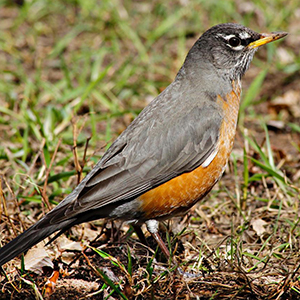
by Sheila Dunning | Dec 13, 2019
 As the migratory birds stop off or stay in the Panhandle this winter, they need to find food, food and more food. There is a wide variety of migration activity in Florida beginning in the fall months of September, October, and November. From woodland song birds to waterfowl to the annual warbler invasion, so many different species show up in Florida. While year-to-year migration patterns and winter foraging grounds can shift for some species due to a variety of reasons, some birds stay in Florida for the winter months of December, January, and February. Some may arrive early and others may stay late.
As the migratory birds stop off or stay in the Panhandle this winter, they need to find food, food and more food. There is a wide variety of migration activity in Florida beginning in the fall months of September, October, and November. From woodland song birds to waterfowl to the annual warbler invasion, so many different species show up in Florida. While year-to-year migration patterns and winter foraging grounds can shift for some species due to a variety of reasons, some birds stay in Florida for the winter months of December, January, and February. Some may arrive early and others may stay late.
Some North American breeding birds endure harsh winters; however, they are physically suited for cold environments in a number of ways. One, they are able to drop their metabolic rate to a near comatose state using very little energy. Two, they are able to position their feathers, or puff up, to trap heat generated by their own body. Others need to head to warmer climates.
Birds migrate for two reasons. Food and weather avoidance. North American breeding birds who nest in the northern part of the continent will migrate south for the winter. As winter approaches, insect and plant life diminishes in the snow-covered states. Migrating birds head south in search of food. Places like Florida are rich in insects, plant life, and nesting grounds.
Birds need high energy food to stay warm. Berry and seed producing plants contain proteins, sugars and lots of fats. Many native trees, shrubs and grasses can aid migratory and winter visiting birds in their relentless search for food. Gardening for birds and other wildlife enables an opportunity for people to experience animals up close, which providing an important habitat in the urban environment.
For more information on which plants are preferred by specific bird species go to: https://www.audubon.org/native-plants
For more information on landscaping for wildlife refer to: https://edis.ifas.ufl.edu/pdffiles/UW/UW17500.pdf
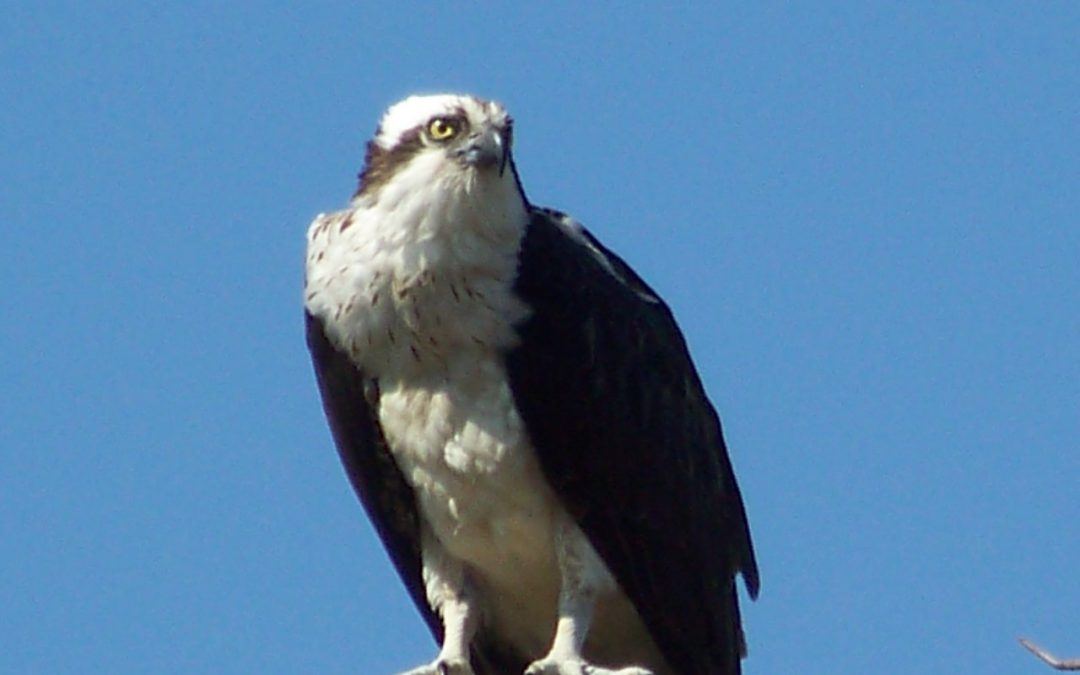
by Carrie Stevenson | Sep 27, 2019
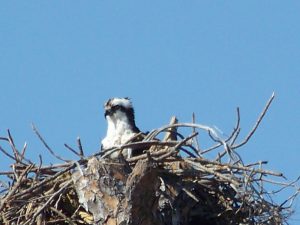
Ospreys, or fish hawks, build their nests from sticks atop dead trees. Photo credit: UF IFAS Extension
Big hurricanes like Dorian (Bahamas) and 2018’s Michael (central Florida Panhandle) were devastating to the communities they landed in. Flooding, wind, rain, loss of power and communications eventually made way for ad hoc clearing and cleanup, temporary shelters, and a slow walk to recovery. Among the most striking visual impacts of a hurricane are the tree losses, as there are unnatural openings in the canopy and light suddenly shines on areas that had been shaded for years. In northwest Florida, pines are particularly vulnerable. After any hurricane in the Panhandle, you can drive down Interstate 10 for miles and see endless pines blown to the ground or broken off at the top. During Hurricane Ivan 15 years ago, the coastal areas in Escambia and Santa Rosa lost thousands of trees not only due to wind, but also to tree roots inundated by saltwater for long periods.
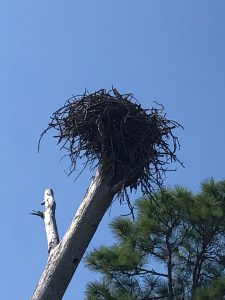
Dead trees left by hurricanes serve as ideal nesting ground for large birds like ospreys. Photo credit: Carrie Stevenson, UF IFAS Extension
Nature always finds a way, though. Because of all those dead (but still-standing) pines, our osprey (Pandion haliaetus) population is in great shape in the Pensacola area. How are these two things related? Well, ospreys build large stick nests in the tall branches/crooks of dead trees, known as snags. They particularly prefer those near the water bodies where they fish. When I first moved here 20 years ago, I rarely saw ospreys. Now, it’s uncommon not to see them near the bayous and bays, or to hear their high-pitched calls as they swoop and dive for fish.
If you are not familiar with ospreys, they can be distinguished by their call and their size (up to six foot wingspan). It is common to see them in their large nests atop those snags, flying, or diving for fish. I usually see them with mullet in their talons, although they also prey on catfish, spotted trout, and other smaller species. They have white underbellies, brown backs, and are smaller than eagles but larger than your average hawk. One of their more interesting physical adaptations (and identifying characteristics) is their ability to grip fish parallel to their bodies, making it more aerodynamic than the perpendicular method most birds use.
Ospreys mate for life, and cooperate to build nests and care for young. The species has overcome many complex threats—including DDT damage to eggs and habitat loss—but the sight of them flying is always inspiring to me. They are a living embodiment of resilience amidst adversity.
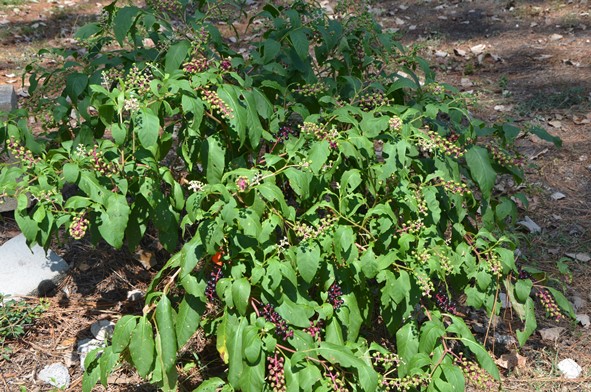
by Les Harrison | Sep 27, 2019

Pokeweed is currently producing many purple berries containing seed ready for avian distribution.
Half a century ago the AM airwaves included a tune by a rock singer who crooned about Polk Salad Annie. While not exactly epic lyrics, it did have a catchy beat which made it to number eight on Billboard’s Hot 100.
The basis of this dish was common pokeweed (Phytolacca americana), a native of North American perennial weed frequently found in pastures as well as fence-rows, fields, wooded areas and neglected residential landscapes.
The reason this plant is only on the menu of the economically distress is all parts of it contain saponins, oxalates, and the alkaloid toxin phytolacine. The roots and seeds of this species contain the highest concentrations of these compounds.
As winter moves to spring, this plant is emerging from its winter dormancy. The warm summer of 2019 has accelerated the regrowth in north Florida and the surrounding states.
Once pokeweed becomes established, it regrows each year from a large, fleshy taproot which penetrates over a foot deep. The crown of the root is where the plant is regenerated and can be as large as five and a half inches in diameter at the soil surface within two growing seasons.
Pokeweed usually has a red trunk like stem, which becomes hollow as the plant matures later in the year. Leaves become quite large as the plant grows to its full potential and are the basis for the Polk salad.
The process for rendering the leave edible by humans, or other mammals, involves boiling and washing with a second boiling and more washing. Short of eminent starvation, it is not a good or safe meal choice for dining.
When in bloom the individual flowers appear green to white and are typically missing petals. Fruits are green when immature and turn a deep purple to black at maturity which is the basis for one alternate name for this species, inkberry.
Each fruit contains about nine small, hard-shelled seeds. Pokeweed can produce a few thousand seeds to over 48,000 seeds per plant annually.
In the right situation these seeds may remain viable in the soil for over four decades (40 years). When exposed to favorable environmental conditions the seed sprout and the process is repeated.
While not a suitable selection for people or livestock, birds eat the fruits without much evidence of harm and are usually the means for seed dispersal. Roosting sites along fence rows and under utility lines frequently show signs of seed deposits.
In addition to feeding cardinals, mocking birds, cedar waxwings and other avian species, the pokeweed is host to a variety of insects. Some are beneficial and others are not.
A number of caterpillars utilize this weed to sustain their larval stage of development. Unfortunately, some other less desirable insects use the local weed, too.
Pokeweed can act as reservoirs of various viruses transmitted by insects which are destructive to vegetable and ornamental plants. Whiteflies and aphids are the main culprits, but other insect species can contribute the disease issue.
Old rock tunes aside, it is best to leave the pokeweed and Polk salad to the bugs and birds.
To learn more about pokeweed read the UF/IFAS publication COMMON POKEWEED.
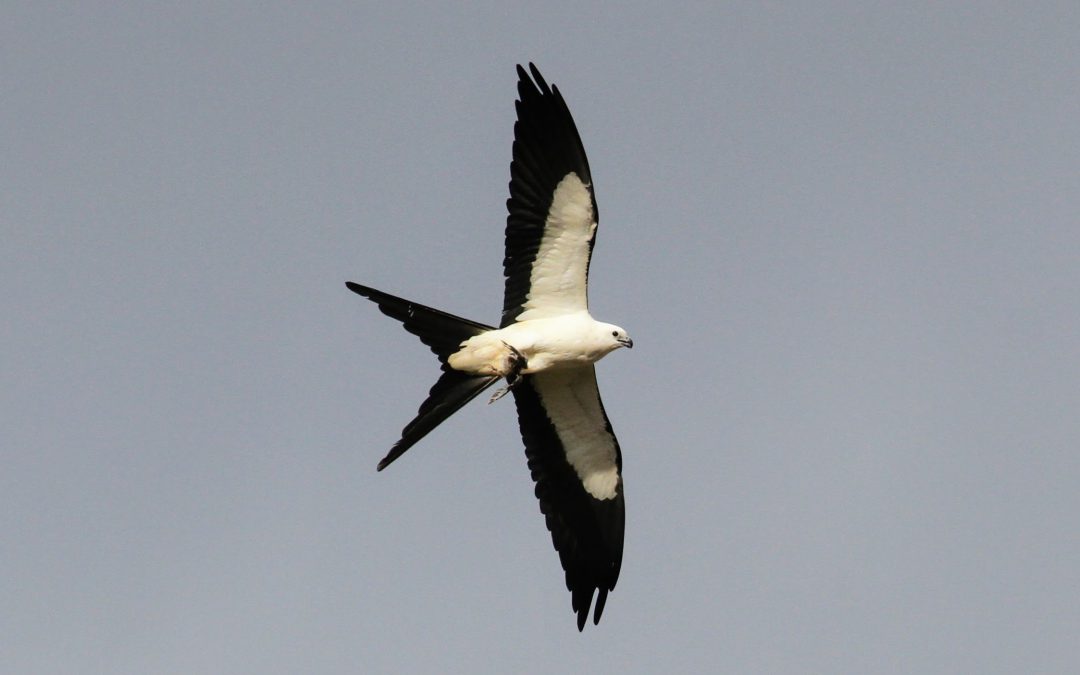
by Erik Lovestrand | Jun 21, 2019
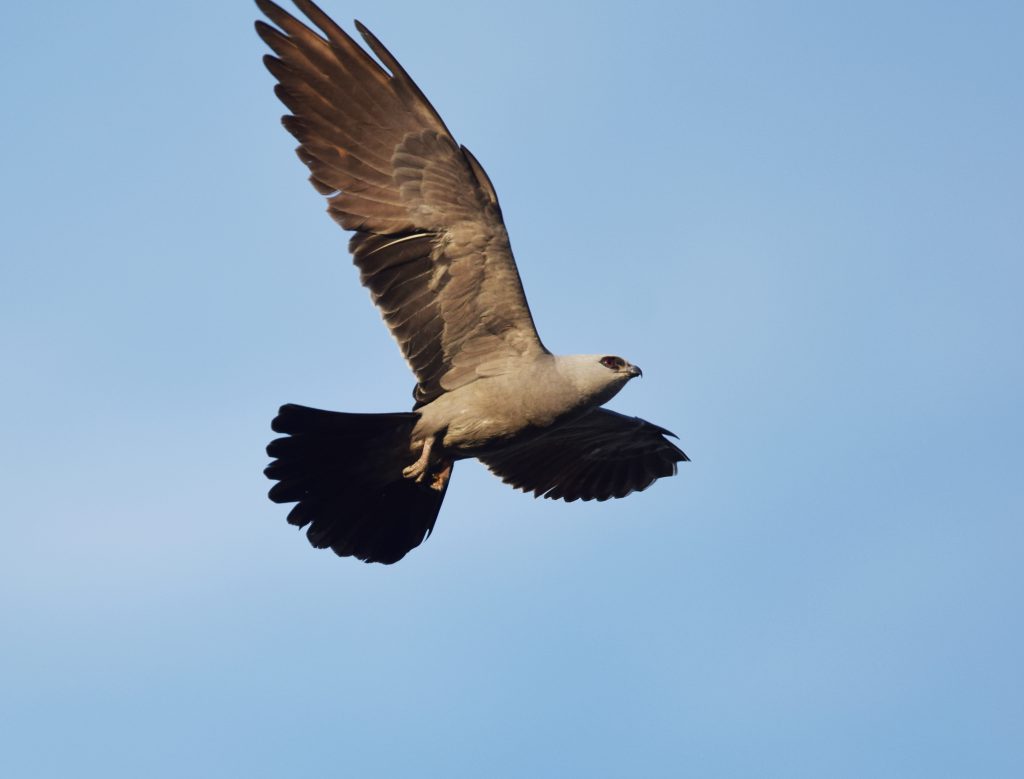
Mississippi kites are smaller but impressive aerialists as well. Photo by Andy Reago, Flickr Creative Commons.
Dime store kites were never very expensive, but it still seemed like a luxury when I was growing up and it was a rare thing for us kids to see a store-bought kite flying over our neighborhood. An old paper grocery bag (remember those), some cotton string for the corner loops, and two dog fennel sticks cut from the back field provided the basic ingredients for us to make our own. With a little creative cutting and gluing, and the attachment of a tail made from torn strips from a worn-out shirt, it was a thing of grace and beauty and was soon aloft on the wind. On a good day, with the right breeze (not too light, not too gusty), we could run out two full rolls of kite string until the kite was just a speck in the distance. The real challenge was winding all of that string back in after the kite came down across houses, powerlines and fields.
Please forgive the digression but thinking about the topic for this article sent me on a little trip down memory lane. We are fortunate to have two very interesting avian species of kites that grace our summer skies over North Florida. Both are exceptional aerialists but one of them in particular will leave a visual image that is hard to shake. The swallow-tailed kite (Elanoides forficatus) is one of the most impressive birds on the planet with its stark white belly and under-wing coverts, outlined in bold black trim. Its deeply forked tail gives rise to several descriptive names such as split-tailed hawk and fork-tailed hawk, among others. Each spring, swallow-tailed kites migrate in small groups back to their breeding range that extends into the Florida Peninsula and sections of the Panhandle, including several North Florida counties. I’ve seen up to 21 kites flying over the Apalachicola River floodplain during this time of year. Forested swamp habitats along river corridors are particularly valuable for foraging and nesting areas but these graceful flyers are also observed over agricultural fields and pastures where they catch dragonflies and other bugs on the wing; usually dining in the air. Nesting takes place in treetops and young are fed a mixed bag of insects, tree frogs, lizards and small snakes, most snatched from the treetops in flight. Occasionally, the young of other birds are taken from their nests and added to the menu. After the young have fledged from the nest, it isn’t long before our kites head back to their wintering grounds in South America. Young birds can be identified by their less-deeply forked tail, due to the short outer tail feathers.
The other kite that graces our area during summertime is the Mississippi kite (Ictinia mississippiensis); not quite as flashy as its fork-tailed cousin but beautiful in its own right. Adult Mississippi kites are a pearly gray color with darker wings and tail. They are significantly smaller, with a wingspan of about 3 feet (swallow-tailed kites have a wingspan up to 4.5 feet). Wintering grounds are in South America also but the breeding range in the US includes several western states such as Texas, Oklahoma and even sparsely in New Mexico and Arizona. This species is known to vigorously defend its nest by dive-bombing trespassers who get too close.
I see both species flying around my house in Wakulla County and without fail, I pause to appreciate the grace, beauty and tremendous distances covered during annual flights by these long-distance migrants. Keep looking up during our summer months and you may well be rewarded by a glimpse of these two “kites over North Florida.”
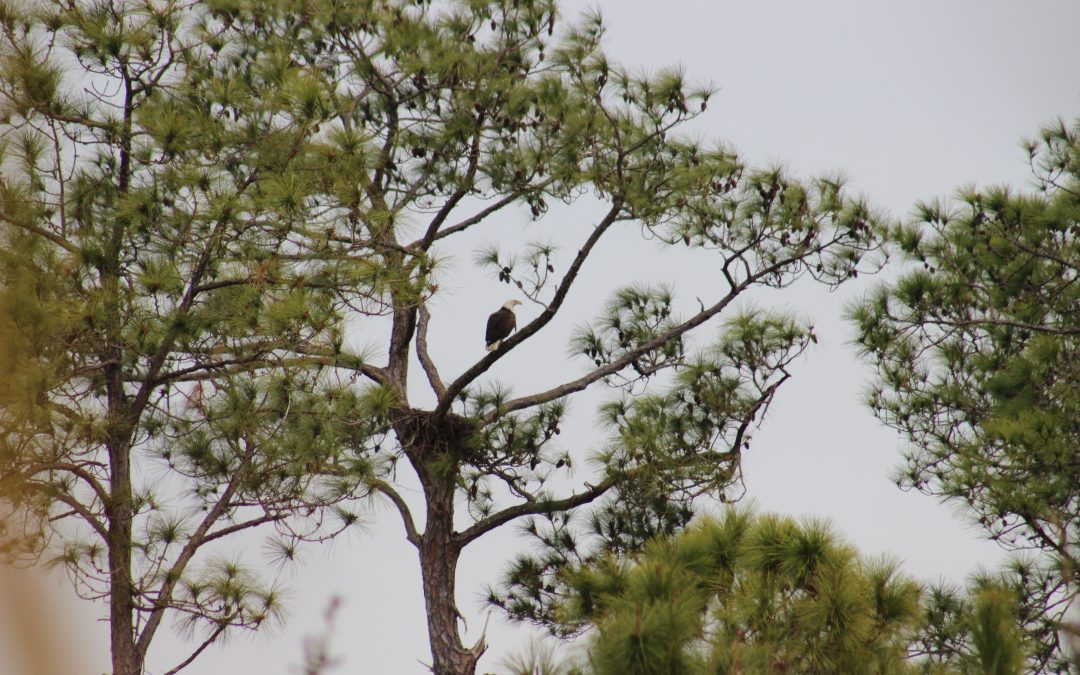
by Rick O'Connor | Feb 10, 2019
On a recent trip to Santa Rosa Island, my wife saw two bald eagles flying down the shore of Santa Rosa Sound. Wanting photos of the nest, we searched and found two individuals in a small nest (for an eagle) in a tall pine. One individual was an adult, the other a juvenile.
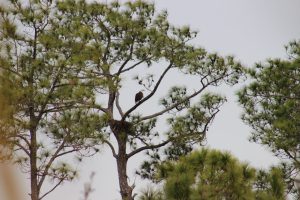
Bald eagle nest on Santa Rosa Island.
Photo: Molly O’Connor
Seeing bald eagles is like seeing bottlenose dolphins. I do not care how many times you have seen them over the course of your life, it is always exciting. Growing up here, I do not remember these animals in our area. Of course, their numbers suffered greatly during the DDT period, and poaching was (and still can be) a problem. But both the banning of DDT and the listing on the Endangered Species List did wonders for this majestic bird. They now estimate over 250,000 breeding populations in North America and 88% of those within the United States. Florida has some of the highest densities of nests in the lower 48 states. Though the bird is no longer listed as an endangered species, it is still protected by the Florida Eagle Rule, the federal Migratory Bird Treaty, and the federal Bald and Golden Eagle Protection Act.
It was shortly after Hurricane Ivan that someone told me they had seen a bald eagle in the area. My first reaction was “yea… right… bald eagle”. Then one afternoon on my back porch, my wife and I glanced up to see two flying over. Now we see them every year. The 2016 state report had 12 nesting pairs in the Pensacola Bay area. They were in the Perdido Bay area, Escambia Bay area, Holly-Navarre area, and Pensacola Beach area. Many locals now see these birds flying over our coastlines searching for food and nesting materials on a regular basis.
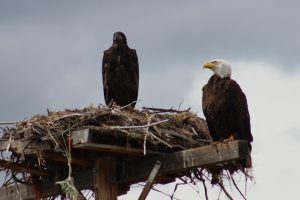
An adult and juvenile bald eagle on nest in Montana.
Photo: Molly O’Connor
Bald eagles are raptors with a thing for fish. However, they are opportunistic hunters feeding on amphibians, reptiles, crabs, small mammals, and other birds. They are also notorious “raiders” stealing fish from osprey, other raptors, and even mammals. They are also known scavengers feeding on carrion and visiting dumps looking for scraps. Benjamin Franklin was in favor of the turkey for our national emblem because the bald eagle was of such low moral character – referring their stealing and scavenging habit.
The Cornell Lab of Ornithology list the bald eagle as a year-round resident along the Gulf coast, but most of us see them in the cooler months. Their nesting period is from October through May. They select tall trees near water and build their nest just below the crown of the canopy. One local ecotourism operator has noticed their preference for live trees over the dead ones selected by osprey. Eagle nest are huge. A typical one will be 5-6 feet in diameter and 2-4 feet tall. The record was a nest found in St. Pete FL that was 10 feet in diameter and over 20 feet tall! The inside of the nest is lined with lichen, small sticks, and down feathers. One to three eggs are typically laid each season, and these take about 35 days to hatch. Both parents participate in nest building and raising of the young.
Viewing bald eagles is amazing, but approaching nests with eggs, or hatchlings, can be stressful for the parents. Hikers and motorized vehicles should stay 330 feet from the nests when viewing. Bring a distance lens for photos and be mindful of your presence.
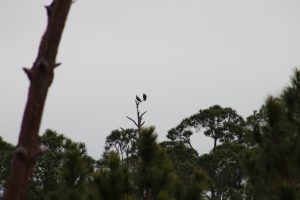
An adult and juvenile bald eagle are perched in a dead tree near their nest.
Photo: Molly O’Connor
No matter how times you see these birds, it is still amazing. Enjoy them.
References
Florida Fish and Wildlife Conservation Commission. Bald Eagle Management. 2018. https://myfwc.com/wildlifehabitats/wildlife/bald-eagle/.
Jimbo Meador, personal communication. 2017.
Williams, K. 2017. All About Birds, the Bald Eagle. Cornell University Lab of Ornithology. https://www.allaboutbirds.org/guide/Bald_Eagle/overview.
by Les Harrison | Jan 4, 2019
Florida’s park system has many unique and quality experiences to offer visitors, but few stand out as much as The Edward Ball Wakulla Springs State Park. It is home of the world’s largest and deepest freshwater springs.
The brisk water is home to manatees, alligators and a host of diverse wildlife which can be viewed from the shore or a boat. Each season delivers a different selection of birds passing through and offering birdwatchers a prime destination to see the avian residents and visitors in a natural setting.
The bracing, some say chilly, 70 degree waters are sure to refresh bathers even during the hottest summer days. For some human visitors ankle deep is enough to experience.
Wakulla Springs’ history extends back thousands of years with evidence of varied use by people and animals, some long gone. Early residents lived in shoreline villages and took advantage of the plentiful natural resources to support their idyllic existence.
One novel use of the area was by filmmakers who appreciated the primeval quality of the park’s swamps and wildlife as a backdrop for cinematic productions. Hollywood films such as Tarzan’s Secret Treasure (1941) and Creature from the Black Lagoon (1954) were shot at this location.
The historic lodge is an elegant remnant of old Florida, and set among the ancient cypress trees which surround the swamps. The Spanish style lodge with its period furniture, original elevators and colorful painted ceilings that depicts wildlife and Old Florida scenes still takes lodgers.
For the adventurous, there are several hiking trails requiring varying degrees of exertion. For more information about the park’s amenities visit their website: https://www.floridastateparks.org/parks-and-trails/edward-ball-wakulla-springs-state-park

 As the migratory birds stop off or stay in the Panhandle this winter, they need to find food, food and more food. There is a wide variety of migration activity in Florida beginning in the fall months of September, October, and November. From woodland song birds to waterfowl to the annual warbler invasion, so many different species show up in Florida. While year-to-year migration patterns and winter foraging grounds can shift for some species due to a variety of reasons, some birds stay in Florida for the winter months of December, January, and February. Some may arrive early and others may stay late.
As the migratory birds stop off or stay in the Panhandle this winter, they need to find food, food and more food. There is a wide variety of migration activity in Florida beginning in the fall months of September, October, and November. From woodland song birds to waterfowl to the annual warbler invasion, so many different species show up in Florida. While year-to-year migration patterns and winter foraging grounds can shift for some species due to a variety of reasons, some birds stay in Florida for the winter months of December, January, and February. Some may arrive early and others may stay late.









